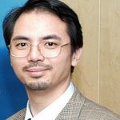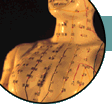|
 |
Introduction to TCM

Basics of TCM

• Yin-Yang | Five Elements

Zang-Fu Theories

• Zang Organs | Fu Organs

Classification of Antineoplastic Herbal Medicines

Characteristics of Herbal Medicines

Diagnose

• By Auscultation & Olfaction
• By Inspection

Prescriptions

Theories of Channels (Meridians) and Collaterals

Reference: A Modern View of the Immune System

Differentiation of Syndromes

• 8 Principles
• 6 Channels 4 Stages
• Syndromes of Zang-Fu Organs

Etiology

• Exogenous
| Pestilential
• Pathogenic Factors
• Emotional

Materia Medica


Back to Home

|
 |

The Basic Content of Yin-Yang Theory
The Opposition of Yin and Yang
The theory of Yin-Yang holds that every object in the
universe consists of two opposite aspects which are in continual
mutual restriction and interaction. The alternation of the four
seasons is an example. The spring is warm and the summer hot.
This is due to the rising of yang qi which restricts the autumn
cool and the winter cold. Alternately, the coolness of autumn
and cold of winter arise because of the ascendancy of yin
that restricts the spring warmth and summer heat. According
to Yin-Yang theory, the seasonal cycle is the outcome
of the mutually restrictive and mutually consuming-increasing
activities of yin and yang. Either side of the two opposites
always restricts and acts on the other. This process of mutual
restriction and interaction is the operation of yin and yang,
without which change would not occur. Thus the two opposites
of yin and yang do not exist as an entity in a still and
unconcerned state. They constantly interact with each other,
hence the alteration and development of an object.
Yin and Yang Interdependence
Yin and yang are at once in opposition and in interdependence.
They rely on each other for existence, coexisting in a
singe entity. Each of the two aspects is the condition for
the other's existence and neither can exist in isolation.
For example, daytime is yang, night in yin, without day
there would be no night; upper is yang, lower is yin;
left is yang, right is yin, etc., each pair exists in a state of
mutual dependence, and without its opposite it could not exist.
The interdependent relationship of yin and yang is
described in the Suwen, "Yin is installed in the interior
as the material foundation for yang, while yang remains on
the exterior as the manifestation of the yin function." This is
a traditional explanation of the interdependence of yin and yang.
The Mutual Consuming-Increasing Relationship of Yin and Yang
The yin and yang aspects within an object are not quiescent,
but in a state of constant motion. They can be described as
being in a state where the lessening of yin leads to an increase
of yang, or vise versa. Taking the transformation of the
seasons as an example, in terms of the Yin-Yang theory, the
process of transition from winter cold through spring warmth into
summer heat demonstrates the process of a lessening of yin
leading into an increasing of yang. While the transition from the
heat of summer to the cold of winter is the lessening of yang
leading to an increasing of yin.
Regarding the human body's functional activities,
which are considered yang, the consumption of nutrient substances,
which are considered yin, results in the lessening of yin to
the increase of yang. As the metabolism of nutrient substances
(yin) exhausts the functional energy (yang) to a certain extent,
this is understood as a lessening of yang to the increase of yin.
Under normal conditions the mutual consuming and increasing
of yin and yang maintain a relative balance. Under abnormal
conditions there is an excess or insufficiency of either yin
or yang which leads to the occurrence of disease.
Yin and Yang's Mutual Transforming Relationship
In certain circumstances and at a certain stage of development,
each of the two aspects of yin and yang, within an object,
will transform from yin into yang and from yang into yin.
The mutual consuming-increasing of yin and yang is a process
of quantitative change, and the mutual transformation of yin and yang
is a process of qualitative change. The Suwen comments, "Extreme
cold will bring about heat, and extreme heat will induce cold...";
furthermore, "Excessive yin may cause yang syndromes or
tend to be transformed into yang and vice versa." These are
the features and conditions of the mutual transformation of yin and yang.
The mutual transformation of yin and yang is often seen
during the development of a disease. For example, if a patient
has a constant high fever, which is suddenly lowered, accompanied
by a pale complexion, cold limbs, extremely feeble pulse
(the danger symptoms of yin cold syndromes), we may say that
the disease has transformed from a yang syndrome into a yin
syndrome. Under these circumstances, proper emergency treatment
should warm the limbs to make the pulse normal.
The yang qi will recover, and the danger will be removed.
Thus yin syndromes can change into yang syndromes.
Clinical practice provides other examples of the mutual
transformation of yin and yang. It is common in clinical
practice to have exterior syndromes transform into interior
syndromes or vice versa and shi (excess) syndromes may
change into xu (deficiency) syndromes or vice versa.
The above-mentioned relationships of mutual
opposing, depending, consuming-increasing, and transforming
of yin and yang are the basic content of Yin-Yang theory.
Furthermore, these four relationships between yin and yang
are not so isolated from each other but interconnect
with and interact upon each other.
Related Subjects
The Application of Yin-Yang Theory to the Field of Traditional Chinese Medicine
|

|
|
|
|
|
 |

|
WHAT IS TRADITIONAL CHINESE MEDICINE?

Photo © Image DJ Image Dictionary
With over 3000 years of experience, Traditional Chinese Medicine (TCM) has
remain one of the many fascinating areas in ancient Chinese culture.
First known to be documented in the Yellow Emperor's Canon of Medicine,
TCM is believed to have been practised in as early as 475 to 221 B.C.
The field of working knowledge of TCM stretches from anything related to
general healthcare practice to the philosophy of the mind, the logic of life,
religion, and even to as far as cosmology and astronumerology. This is why
in order to thoroughly understand the concepts behind TCM, one must be
comprehensive in learning and embracing the Chinese culture as a whole.
Just as Douglas Hoff put it when he explained about accupuncture, "The systems
of TCM uses the concepts of elements and meridians and are completely immersed
in the Asian cosmology which takes shape through the religions." The meridian-brain mechanism,
the fundamental working concept of acupuncture, in which the pain block from the message
that the needle or burning cone of herbs gives to the point of stimulus,
was only found centuries later by the West through science and technology.
|
| |
|
MESSAGE FROM THE EDITOR – MARCH 2020
 Thank you for visiting this TCM and acupuncture information website.
If you have previously been to this website, you might have
noticed that some of the pages on ancient historical ideas and
holistic thinkings related to Chinese metaphysics are temporarily taken offline.
This is because I will be revamping the whole website and be moving
those information into a new \"Ancient Chinese Culture\" section
so as to reflect a more current perspective on the interpretation
of some of the fundamental concepts as well as to include
some of the latest information in the area.
But if you have just found this website for the very first time, I welcome you again and
wish you could find what you require and, hopefully, you could also be benefitted
from reading the articles I published on this website.
Thank you for visiting this TCM and acupuncture information website.
If you have previously been to this website, you might have
noticed that some of the pages on ancient historical ideas and
holistic thinkings related to Chinese metaphysics are temporarily taken offline.
This is because I will be revamping the whole website and be moving
those information into a new \"Ancient Chinese Culture\" section
so as to reflect a more current perspective on the interpretation
of some of the fundamental concepts as well as to include
some of the latest information in the area.
But if you have just found this website for the very first time, I welcome you again and
wish you could find what you require and, hopefully, you could also be benefitted
from reading the articles I published on this website.
Please be patient and do come and check out this website frequently as it's being revamped.
Raymond Cheng, PhD DPA FRSA FRSPH

March 28, 2020.
|

|
IMPORTANT NOTICE AND DISCLAIMER

 This website is published, edited and designed by Raymond Cheng,
and reflects only and only his personal views and opinions in his individual capacity.
The information available at this website is not intended
directly or by implication to either diagnose or treat any
medical, emotional, or psychological condition or disorder.
It is also not intended to create a physician-patient relationship
between you and I or between you and Wyith Institute™ and The Office of Dr Raymond K K Cheng.
The information here is not a substitute for advice and treatment provided
by your physician or by another healthcare professional.
It is always recommended that consultation with local healthcare providers
be obtained for any of your specific health or medical concerns.
Furthermore, any products that can be purchased (yet you can see I don't have much
to sell here) through advertisers' banners or through links to other websites
are not either explicitly or implicitly given any warranty or endorsement
by me, my colleagues, Wyith Institute™ or any of its associated businesses.
This website is published, edited and designed by Raymond Cheng,
and reflects only and only his personal views and opinions in his individual capacity.
The information available at this website is not intended
directly or by implication to either diagnose or treat any
medical, emotional, or psychological condition or disorder.
It is also not intended to create a physician-patient relationship
between you and I or between you and Wyith Institute™ and The Office of Dr Raymond K K Cheng.
The information here is not a substitute for advice and treatment provided
by your physician or by another healthcare professional.
It is always recommended that consultation with local healthcare providers
be obtained for any of your specific health or medical concerns.
Furthermore, any products that can be purchased (yet you can see I don't have much
to sell here) through advertisers' banners or through links to other websites
are not either explicitly or implicitly given any warranty or endorsement
by me, my colleagues, Wyith Institute™ or any of its associated businesses.
|

|
|

 This website is published, edited and designed by Raymond Cheng,
and reflects only and only his personal views and opinions in his individual capacity.
The information available at this website is not intended
directly or by implication to either diagnose or treat any
medical, emotional, or psychological condition or disorder.
It is also not intended to create a physician-patient relationship
between you and I or between you and Wyith Institute™ and The Office of Dr Raymond K K Cheng.
The information here is not a substitute for advice and treatment provided
by your physician or by another healthcare professional.
It is always recommended that consultation with local healthcare providers
be obtained for any of your specific health or medical concerns.
Furthermore, any products that can be purchased (yet you can see I don't have much
to sell here) through advertisers' banners or through links to other websites
are not either explicitly or implicitly given any warranty or endorsement
by me, my colleagues, Wyith Institute™ or any of its associated businesses.
This website is published, edited and designed by Raymond Cheng,
and reflects only and only his personal views and opinions in his individual capacity.
The information available at this website is not intended
directly or by implication to either diagnose or treat any
medical, emotional, or psychological condition or disorder.
It is also not intended to create a physician-patient relationship
between you and I or between you and Wyith Institute™ and The Office of Dr Raymond K K Cheng.
The information here is not a substitute for advice and treatment provided
by your physician or by another healthcare professional.
It is always recommended that consultation with local healthcare providers
be obtained for any of your specific health or medical concerns.
Furthermore, any products that can be purchased (yet you can see I don't have much
to sell here) through advertisers' banners or through links to other websites
are not either explicitly or implicitly given any warranty or endorsement
by me, my colleagues, Wyith Institute™ or any of its associated businesses.



 Thank you for visiting this TCM and acupuncture information website.
If you have previously been to this website, you might have
noticed that some of the pages on ancient historical ideas and
holistic thinkings related to Chinese metaphysics are temporarily taken offline.
This is because I will be revamping the whole website and be moving
those information into a new \"Ancient Chinese Culture\" section
so as to reflect a more current perspective on the interpretation
of some of the fundamental concepts as well as to include
some of the latest information in the area.
But if you have just found this website for the very first time, I welcome you again and
wish you could find what you require and, hopefully, you could also be benefitted
from reading the articles I published on this website.
Thank you for visiting this TCM and acupuncture information website.
If you have previously been to this website, you might have
noticed that some of the pages on ancient historical ideas and
holistic thinkings related to Chinese metaphysics are temporarily taken offline.
This is because I will be revamping the whole website and be moving
those information into a new \"Ancient Chinese Culture\" section
so as to reflect a more current perspective on the interpretation
of some of the fundamental concepts as well as to include
some of the latest information in the area.
But if you have just found this website for the very first time, I welcome you again and
wish you could find what you require and, hopefully, you could also be benefitted
from reading the articles I published on this website.